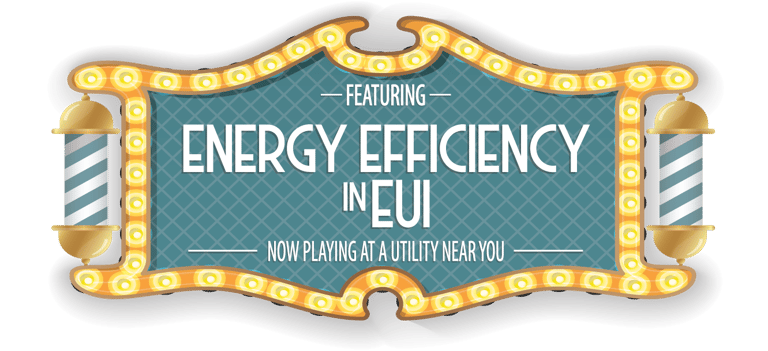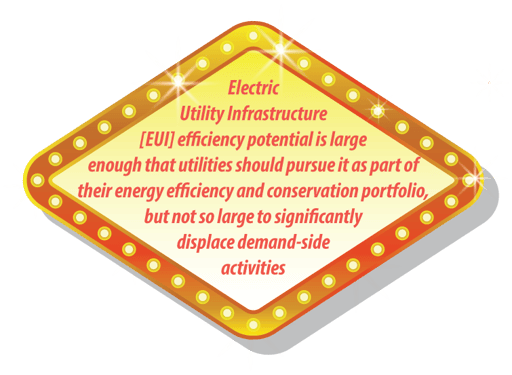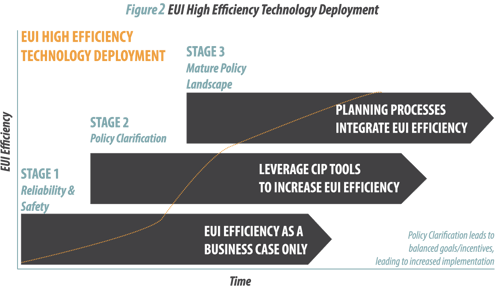- Home
- Services
- Hi-Line Engineering
- About
- Careers
- Contact
- Requests For Proposals
Energy Efficiency in EUI
by GDS Associates, Inc | August 22, 2019 | News , Newsletter - TransActions
 Over the last two and a half years, the Minnesota Department of Commerce (”Department”) completed a series of projects aimed at improving energy efficiency in the state’s Electric Utility Infrastructure (EUI). EUI is defined as utility-owned assets used to deliver electric energy to customers, which includes distribution, transmission, generation, and miscellaneous utility facilities. These projects created technical and policy tools to clarify opportunities and incentives to help utilities drive efficiency improvements of their infrastructure. Examples of opportunities include: low loss conductors, conservation voltage reduction, improved heat rates at generation facilities, and high efficiency transformers.
Over the last two and a half years, the Minnesota Department of Commerce (”Department”) completed a series of projects aimed at improving energy efficiency in the state’s Electric Utility Infrastructure (EUI). EUI is defined as utility-owned assets used to deliver electric energy to customers, which includes distribution, transmission, generation, and miscellaneous utility facilities. These projects created technical and policy tools to clarify opportunities and incentives to help utilities drive efficiency improvements of their infrastructure. Examples of opportunities include: low loss conductors, conservation voltage reduction, improved heat rates at generation facilities, and high efficiency transformers.
In Minnesota, utilities are required by State legislation to develop conservation plans to achieve energy savings equal to 1.5 percent of average annual retail sales. Similar requirements are common across the country and utilities are constantly looking for new technologies and tools to help them meet their conservation goals. The aim of these EUI conservation projects is to unlock infrastructure efficiency as a new tool to help utilities cost-effectively meet their goals and better serve their retail customers. Despite statutory clarity that EUI projects can be used as a conservation tool in Minnesota, until now there had been significant uncertainty how EUI efficiency could be leveraged within the regulatory framework.

The Department worked with expert consultants and a wide variety of stakeholders to complete the series of projects and achieve final outcomes including:
- A statewide Potential Study to quantify infrastructure efficiency opportunities and identify where those opportunities can be found
- An Action Plan to clarify the policy landscape surrounding EUI and recommend actions for stakeholders to capture EUI efficiency opportunities
- New Technical Reference Manual measures to standardize methods of calculating energy efficiency conservation for some common infrastructure improvements
- A series of policy guidance documents and technical tools to help lower barriers to implementing projects
The findings from these projects reduce the uncertainty and lower barriers to implementing EUI projects. For utilities in other states that may wish to apply lessons learned from this project, the first step is to clarify the eligibility of EUI for achieving established conservation goals, then all other findings can be extrapolated with minor adjustments.
EUI Potential Study
A statewide EUI Potential Study identifies and quantifies conservation opportunities in EUI assets owned and operated by electric utilities. The models developed for the study estimate that the “achievable” potential for EUI efficiency is approximately 106,465 MWh of annual average conservation. This corresponds to approximately 9% of utilities’ predicted conservation goals over that time. “Achievable” is a term of art used in potential studies to indicate that the identified conservation is both economically feasible and can be implemented in a reasonable timeframe. This can be contrasted with “technical” potential which assumes technology is the only limiting factor (not money or time). The ultimate takeaway from the study is:

This study uses a unique approach to estimate potential in EUI sectors, accordingly, there are important differences between this study and a conventional demand-side study that should be understood to properly interpret results. For example, the meaning of “achievable” potential depends on how utilities make decisions rather than predicting utilities’ ability to influence end user decisions.
For full results and descriptions of the methodology used, see the final report: http://mn.gov/commerce-stat/pdfs/card-gds-eui-potential.pdf
Action Plan
Through a U.S. Department of Energy State Energy Program grant, the Department of Commerce project team undertook a stakeholder engagement process to address uncertainty regarding how EUI efficiency improvements fit into Minnesota’s existing policy and regulatory framework. Stakeholders included investor-owned, municipal, and cooperative utilities as well as advocacy groups, technology manufacturers, policymakers, and an impressive array of experts to provide perspective on relevant subjects. Ultimately, the final Action Plan consists of recommendations for stakeholders to unlock the potential of EUI efficiency and build momentum toward implementation.

Figure 2 illustrates the long-term vision of EUI as a viable tool to help meet conservation goals. Currently, infrastructure design is largely driven by reliability and safety parameters. This Action Plan represents the climb from Stage 1 to Stage 2 by raising awareness of infrastructure efficiency opportunities and leveraging policy tools to capture those opportunities. If successful, the Action Plan will help drive EUI efficiency implementation projects and lead to further clarifications of policy objectives. Ultimately, the goal is to seamlessly incorporate efficiency considerations into the infrastructure design process, with a full understanding of their value in terms of helping meet conservation goals, as represented by Stage 3 in the figure.
To achieve increased certainty, the final Action Plan lays out concrete next steps for stakeholders. To develop recommendations, the project team spoke with stakeholders about barriers to implementing EUI efficiency projects and developed consensus solutions to reduce those barriers. The Action Plan consists of fifteen major recommendations and twenty-nine specific sub-recommendations. The following list is a summary of the six most important recommendations:
Build Partnerships • Utilities should consciously build connections between infrastructure planning teams and CIP personnel to increase awareness of EUI efficiency options and to identify opportunities to leverage CIP resources in the infrastructure planning process.
Connect EUI Efficiency to Grid Modernization and Other Related Efforts • As utilities consider strategies to modernize the grid, they should also consider the possible impacts of increased infrastructure efficiency in terms of helping to achieve conservation goals. Grid Modernization is an umbrella term that applies to any number of technologies and strategies for upgrading grid performance.
Review Policy Guidance • Utilities and other stakeholders should review the policy guidance documents to clarify the role of EUI efficiency within utility conservation policy framework. In particular, utilities should become familiar with the “EUI Project Review and Approval Process” guidance issued potential projects. These tools can be found at: http://mn.gov/commerce-stat/xls/electric-infrastructure-efficiency-screening.xlsx
Examine Potential • Utilities should reference the EUI potential study conducted in 2018 that found EUI conservation is a worthwhile target of CIP resources in Minnesota. Estimates indicate EUI conservation has the potential to achieve approximately 9 percent of annual electric utility conservation goals statewide, on average, from 2020-2039.
Collaborate with Policymakers • Utilities should reach out to policymakers with ideas or questions about including EUI in their conservation plans. This is an evolving landscape with the potential for increased understanding and collaboration going forward.
The project webpage includes the full Action Plan report with all recommendations, a description of the methodology used to develop recommendations, summaries of stakeholder conversations and meeting materials, useful links to reference documents, and a link to a summary webinar on findings. The project page can be found at: https://mncee.org/mnsupplystudy/home/
TRM EUI Measures
One of the major barriers to claiming conservation credit for implementing EUI efficiency projects is the uncertainty about how to calculate the value of the credit. This is analogous to demand side conservation projects like lighting and efficient motors. On the demand side, Technical Reference Manual measures have been developed to standardize the methods for calculating energy efficiency credit in terms of metrics established by policymakers (typically kWh, peak kW, or therms). A similar approach was undertaken to develop standard measures for EUI projects. The Minnesota TRM now contains the following measures:
- Conservation Voltage Reduction (CVR)
- Generation Heat Rate Improvements
- High Efficiency Transformers
- Low Loss Transmission/Distribution Conductors
- 28 additional measures adapted from C/I to apply to utility-owned facilities
Utilities now have some additional certainty to calculate savings achieved by EUI efficiency projects, which can then be compared to other efficiency program options and considered as part of the design and decision-making process. The algorithms seen in Figure 3 are an example, outlining how to calculate credit for high efficiency transformers in terms of the kWh metric used to track utility conservation goals.

Conclusion
The Minnesota Department of Commerce has completed a series of unique projects to apply existing conservation tools to drive efficiency improvements in Electric Utility Infrastructure. The projects quantified available conservation potential, clarified relevant policies, created tools to reduce barriers to implementation, and defined an Action Plan for stakeholders to capture the identified opportunity. For electric utilities outside Minnesota that are interested in applying conservation tools in EUI, there are many lessons to be learned from Minnesota’s experience and a great first step is to clarify the eligibility of EUI for achieving established conservation goals within your state. Interested readers can find project materials, including the final Potential Study and Action Plan reports at: https://www.mncee.org/mnsupplystudy/home/
For more information or to comment on this article, please contact:
 Travis Hinck, Project Manager | CONTACT
Travis Hinck, Project Manager | CONTACT
GDS Associates, Inc. – Madison, WI
608.273.0182
Download PDF
Also in this issue: Part II: FERC ROE Policy In A Flux – What’s Happening and Why It Matters
GET OUR NEWSLETTER
RECENT POSTS
Archives
- December 2015 (8)
- January 2016 (6)
- July 2016 (6)
- March 2021 (6)
- May 2022 (6)
- August 2020 (5)
- March 2015 (4)
- January 2019 (4)
- June 2019 (4)
- August 2019 (4)
- February 2020 (4)
- May 2020 (4)
- June 2020 (4)
- December 2020 (4)
- July 2021 (4)
- October 2021 (4)
- April 2024 (4)
- April 2015 (3)
- August 2016 (3)
- February 2017 (3)
- July 2017 (3)
- February 2018 (3)
- February 2019 (3)
- November 2019 (3)
- March 2020 (3)
- April 2020 (3)
- September 2021 (3)
- December 2021 (3)
- August 2022 (3)
- December 2022 (3)
- April 2023 (3)
- July 2023 (3)
- December 2023 (3)
- May 2014 (2)
- February 2016 (2)
- March 2016 (2)
- September 2016 (2)
- November 2016 (2)
- January 2017 (2)
- July 2018 (2)
- November 2018 (2)
- March 2019 (2)
- May 2019 (2)
- July 2020 (2)
- September 2020 (2)
- April 2021 (2)
- August 2021 (2)
- February 2014 (1)
- April 2014 (1)
- July 2014 (1)
- August 2014 (1)
- November 2014 (1)
- February 2015 (1)
- May 2015 (1)
- June 2015 (1)
- November 2015 (1)
- October 2016 (1)
- December 2016 (1)
- October 2018 (1)
- December 2018 (1)
- April 2019 (1)
- July 2019 (1)
- September 2019 (1)
- October 2020 (1)
- November 2020 (1)
- February 2021 (1)
- April 2022 (1)
- July 2022 (1)
- October 2022 (1)
- August 2023 (1)
- October 2023 (1)
Categories
- News (78)
- Newsletter - TransActions (77)
- Employee Spotlight (35)
- Energy Use & Efficiency (27)
- Environment & Safety (10)
- Other Specialized Services (9)
- Transmission (7)
- Cyber Security (4)
- Energy Supply (4)
- Power Supply (4)
- Hi-Line: Utility Distribution Services (3)
- Uncategorized (2)
- Utility Rates (2)
- Agriculture (1)
- Hi-Line: Seminars & Testing (1)